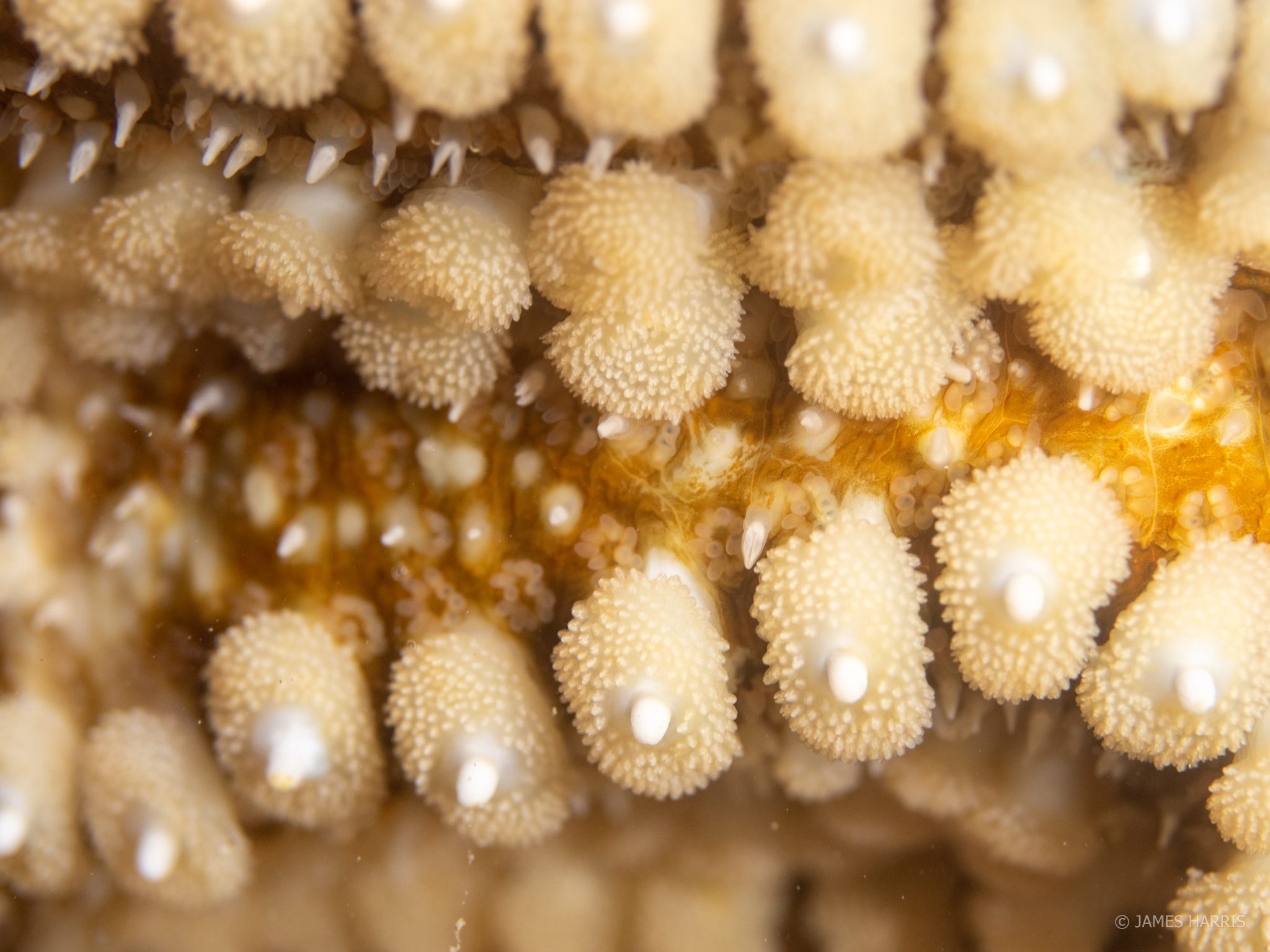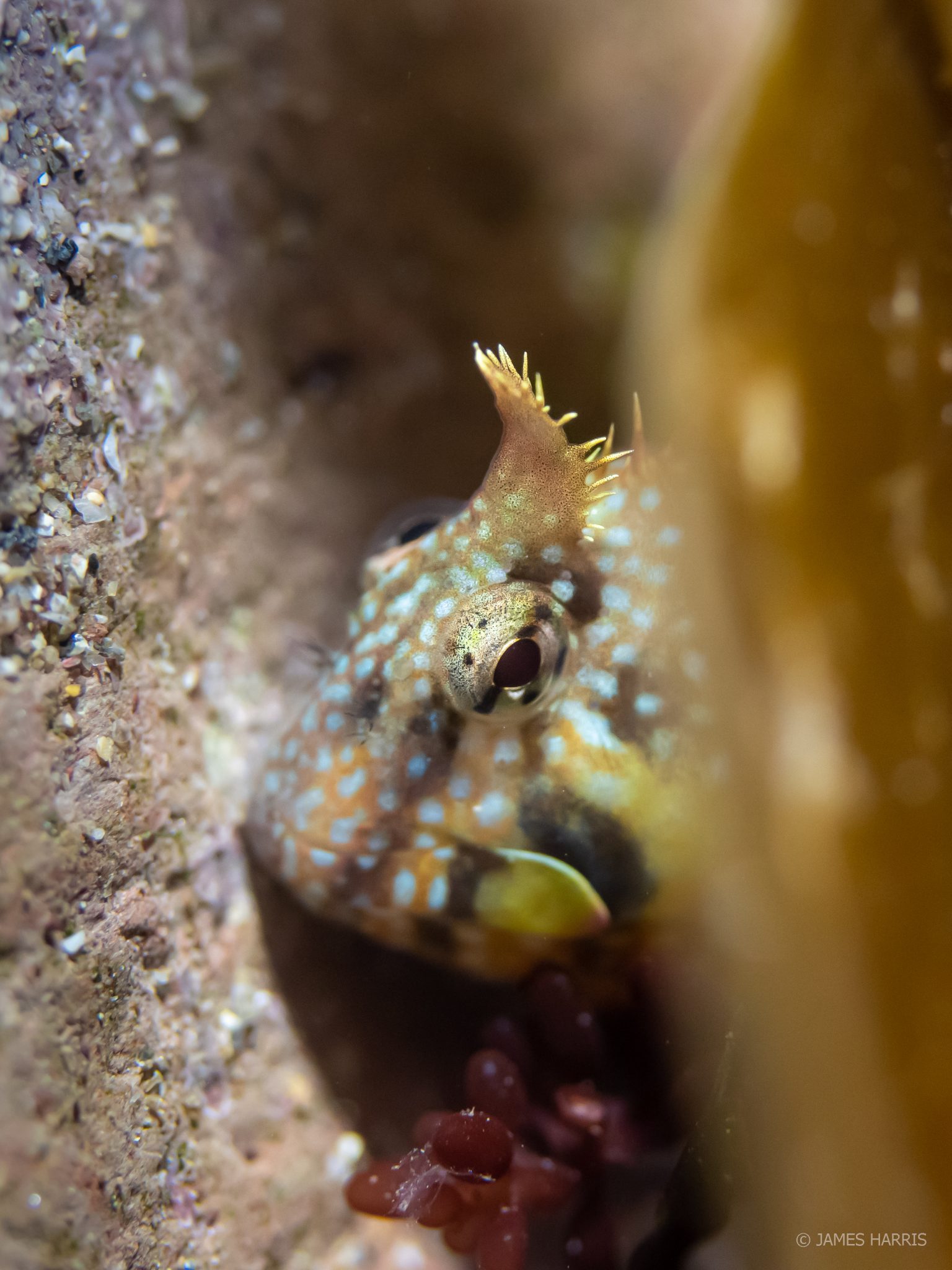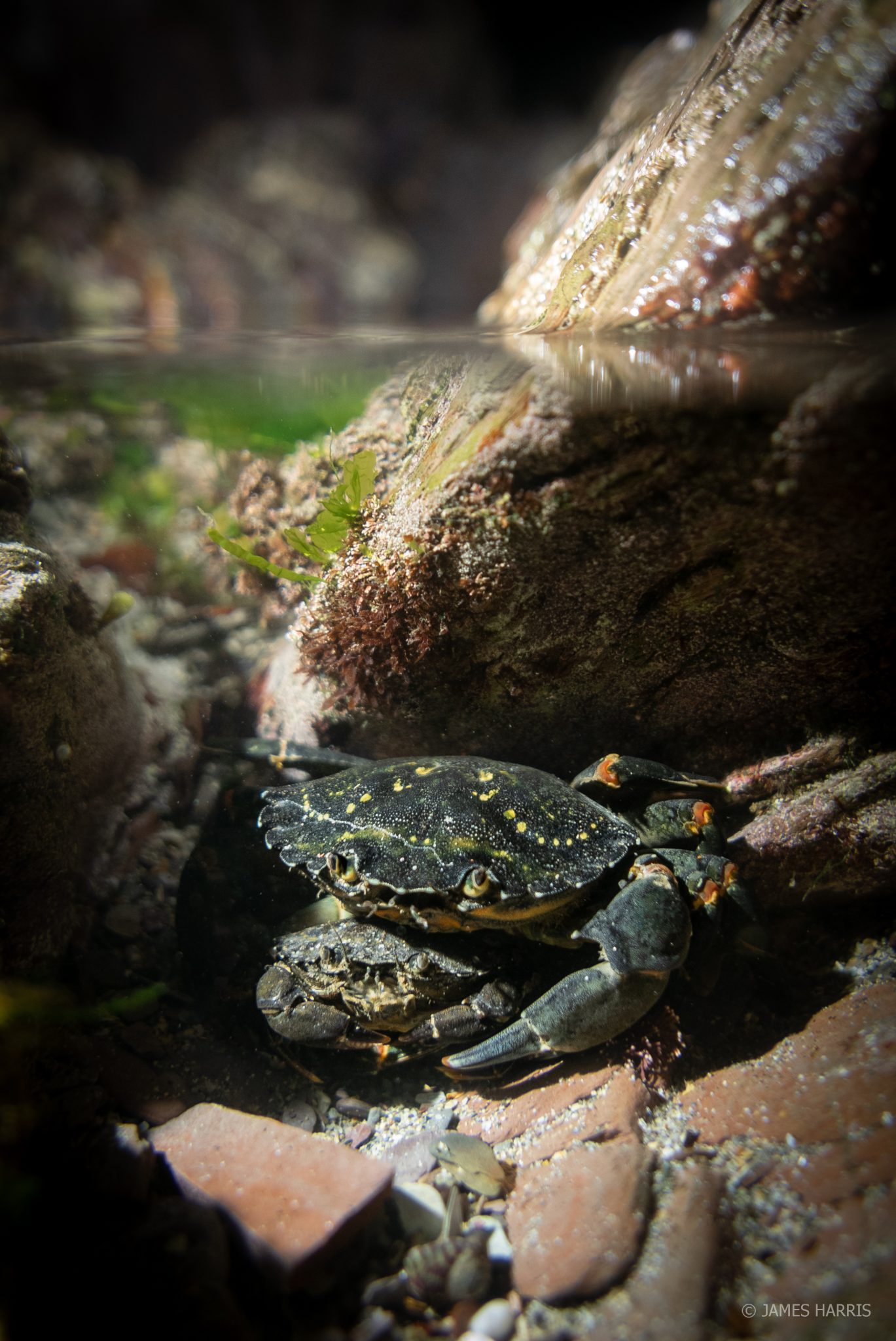News
Underwater photography – without getting wet!

First of all, let’s address the elephant in the room. The image above. It’s a starfish, and those are its spines. OK great, now that that’s out of the way, let’s talk about an underwater (just about) photography idea you might not have considered before: rockpools!
If you’re a warm water diver who enjoys a bit of underwater photography, chances are your camera gear spends more time in storage than in the water. Even us hardy UK divers often leave the camera at home when diving our local site, there’s no denying it’s another thing to worry about.
This is where rockpool photography comes into play. Don’t get me wrong, this type of underwater photography certainly brings its own challenges. Swap buoyancy control for slippery footing, gas management for incoming tides, and a foggy mask for a hidden view finder. But here’s the thing; keep your battery charged and when the mood strikes, you can be out the house in 5 minutes, driving to the beach to take some underwater pictures. Rockpool photography enables one key thing, spontaneity. And when you can be spontaneous, your expensive underwater camera is much more likely to get used!
Macro
Get comfortable – rockpools are spiky! If you can bring yourself to embrace the fashion faux pas, gardening knee pads would be a blessing. Personally, I just can’t do it, so a rolled-up jumper has to do. Getting comfortable is particularly important when it comes to the first type of shot I’m going to talk about – macro. The Tompot Blenny above was in about 20cm of water which meant the viewfinder was totally submerged. I also had a tiny depth of field because of the macro lens I was using; look at the surface of the rock on the left to see the focus go in and out. Put these things together and you can guess how many shots it took to get that front eye and head fringe sharp.
Macro in rockpools is great, it allows you to bring to life the overlooked critters hiding right under our noses. It definitely takes some time and patience though and getting comfortable makes the experience much more enjoyable.
When you think there’s nothing to see, keep looking. At first glance, most rockpools look fairly uninteresting. But in a similar way to when you look at the night sky and the stars gradually reveal themselves, the more time you spend looking in a rockpool, the more you will notice.
This Beadlet Anemone, a pretty common sight in UK rockpools, happened to be dealing with a stray claw that had recently been shed by a moulting crab. I didn’t even notice there was something unusual until I was lining up the shot, and it wasn’t until I got home and zoomed in that I realised exactly what it was.
There is more going on in most rockpools than you might think. It’s quite a departure from open water diving where you have space to take everything in, but I promise – keep looking, it’s worth it!
Capture behaviour. You can be forgiven for assuming that rockpools are quite static. They are just full of creatures waiting for a high enough tide to get back to the sea, right? Not necessarily. When I crouched down to take the shot above, I thought there was only one crab. To my surprise, I noticed that there were actually two! The larger of the pair was carrying a smaller crab underneath it, chasing away other critters as it went.
After researching the behaviour, I discovered the two crabs were in a mating embrace. When this happens, a male crab carries a female away from other males where he will guard her for up to six days. During this time, she moults her hard shell (now I think about it – perhaps it was her claw I found in the anemone above?!) in preparation to mate, leaving her vulnerable. Throughout this time, she is totally reliant on him for protection.
Observing behaviour as it unfolds and capturing it with your camera makes you feel connected to rockpools in a more meaningful way than you might be used to. Next time you’re out, watch out for interactions between creatures, you might be surprised how dynamic these habitats are!
Don’t wait for something amazing. If there’s one thing that you are almost guaranteed to see in rockpools, it’s prawns. They are generally semi-translucent, small, and not particularly interesting. But when you get very close, all sorts of colours, textures and intricate physiological features are unveiled.
The Rockpool Prawn above was only about 1.5cm in length and I only really bothered photographing it to practice with my macro lens. It wasn’t until I got home that I noticed the fascinating blue silver detail in the eyes, similar to a fly. Spiky ridges along its back, bright yellow bands and colourful green eye stems were also revealed under the scrutiny of the macro lens
This silly little creature that I generally ignored, was turning into something far more interesting. Don’t wait for something amazing, get shooting because you might be surprised how amazing the mundane is when given some close attention.
Give it a go! The image above was taken during a trip to Wembury Beach by my partner and it was her first time trying underwater photography. She was using a ten-year-old camera and managed to capture a picture as good as any I took.
This shot has such good composition and beautifully captures a moment in time. By getting down low and facing the Hermit Crab head-on, it looks like it’s posing for a portrait. The sprinkle of sand on the top of the shell and the vibrant blue colouring on the legs are the icing on the cake. I love this picture and it’s proof that you don’t have to be a pro to take a great shot. Get out there and give it a go!
Wide-angle & under/over
Put things into context. If you don’t have the equipment/eyesight for macro photography and aren’t sure how your wide-angle setup can be used in a rockpool full of tiny creatures, keep reading.
You might recognise the two Shore Crabs above from an earlier image. That earlier picture was taken using a macro lens whereas this one was an under/over image using a wide-angle lens. Wide-angle is great for this type of shot. The larger dome gives you more glass to position the water line where you want it, allowing you to capture both over and underwater worlds in one shot.
I find this type of picture great for giving some context to your images. They aren’t just random underwater scenes; they are moments in a recognisable environment.
Animals are optional. Now, despite me saying how many hidden creatures will reveal themselves if you look for long enough, those of you with a patience deficiency have another option. Rockpool landscapes are incredible varied and fascinating, particularly if you use a wide-angle lens to capture under/over pictures.
The collage above is a collection of rockpool landscapes I took one evening at Wembury Beach. You can see how different the textures and colours between rock pools within metres of each other can be. From the surface, they look fairly similar, but capturing them in this way allows you to showcase the diversity that’s hidden beneath the water’s surface.
A final thought
If you’re anything like me, one word comes to mind when you imagine taking your underwater camera into a slippery rockpool – awkward. To a certain extent it is, and honestly, it takes a bit of getting used to, but compared to scuba diving, rockpool photography is so convenient. It’s easy to dismiss, but stick with it, stay patient, follow some of the tips above, and you’ll be surprised what you can find just under the water’s surface. Get out there and give it a go and don’t forget to tag me if you post anything online, I’d love to see it!
Gear News
Introducing the TR-80, IR-50 and CS-30 Regulators from DYNAMICNORD

Whether you are a beginner or a professional diver – with the three new main regulators from DYNAMICNORD, everyone will find their favourite regulator. They all look super stylish.
Excellent performance with the TR-80
Quality and performance are the be-all and end-all for regulators. It is not for nothing that the TR stands for Tec Reg. The innovative design of the TR-80 guarantees absolute reliability – even in ice-cold waters.

Perfect breathing effort at 0.8 J/l / certified for diving in waters below 10 degrees / structural design made of solid brass for best cold protection / membrane-compensated design with dry seal of the first stage / reduced exhalation effort thanks to optimized exhalation membrane and bubble deflector / adjustable Venturi (dive/predive) and adjustment knob for individual inhalation comfort / innovative design of the front cover prevents free-flow in strong currents or when diving with scooters / design made of sandblasted brass, matt chrome finish / 2 HP and 4 LP outlets / mouthpiece made of high-quality, anti-allergic silicone for maximum comfort.


Amazing underwater adventures with the IR-50
The IR-50 is the top regulator for advanced and experienced divers. Natural breathing is the essence of this regulator.

Ideal breathing effort at 0.8 J/l /certified for diving in waters below 10 degrees / compensated membrane / adjustable venturi (dive/predive) and adjustment knob for individual inhalation comfort/ outlet valve and deflector for minimum exhalation effort and reduction of bubbles on the face / design made of sandblasted brass, matt chrome finish / 2 HP and 4 NP outlets / mouthpiece made of high-quality, anti-allergic silicone for maximum comfort.


The Workhorse – our CS-30
For diving centres and diving beginners – the workhorse stands for strong construction, reliability and robustness. Perfect for your training.

Optimal breathing effort at 0.8 J/l /recommended for diving in waters above 10 degrees / non-compensated piston / adjustable venturi (dive/predive) / outlet valve and deflector for minimum exhalation effort and reduction of bubbles on the face / design made of sandblasted brass, matt chrome finish / 1 HP and 3 NP outlets / mouthpiece made of high-quality, anti-allergic silicone for maximum comfort.


Octopus OP-30
The OP-30 is the ideal addition to all DYNAMICNORD regulators. It is identical in construction to the CS-30.

The TR-80, IR-50, CS-30 (DIN & INT) regulators and the Octopus OP-30 are available from DYNAMICNORD dealers and in the online store.
DYNAMICNORD – Your Outdoor Companion.
Marine Life & Conservation
Paul Watson Released as Denmark Blocks Japan’s Extradition Bid

Renowned anti-whaling activist Paul Watson has been released from custody in Greenland after spending five months in detention. Denmark’s Justice Ministry rejected Japan’s request for his extradition, citing insufficient guarantees that his time already served in custody would be credited against any potential sentence.
The 74-year-old Canadian-American was arrested on July 21 in Nuuk, Greenland’s capital, when his ship docked to refuel. His arrest was based on a 2012 Japanese warrant related to a 2010 encounter in Antarctic waters. Japan alleged Watson obstructed operations and caused damage to a whaling research ship during efforts to disrupt illegal whaling. Watson has consistently denied these claims, maintaining his commitment to marine conservation.
Denmark, which oversees extradition matters for Greenland, concluded that while the legal conditions for extradition were met, the lack of assurances from Japan regarding time-served credit made extradition untenable.
In a video shared by his foundation, Watson expressed gratitude and relief, saying, “After five months, it’s good to be out… and good to know they’re not sending me to Japan.” He added that the most difficult part of his time in custody was being separated from his two young sons.
Watson is a pioneering figure in marine conservation, known for founding the Captain Paul Watson Foundation in 2022 after decades of activism with the Sea Shepherd Conservation Society. His bold efforts to defend marine life have earned him widespread support, including from celebrities and conservationists. His work has also been featured in the acclaimed reality TV series Whale Wars.
Watson’s lawyer, Jonas Christoffersen, praised the decision, stating, “We are happy and relieved that Paul Watson is now free.” He added that Watson is eager to reunite with his family and continue his vital work.
The arrest occurred while Watson’s vessel, the M/Y John Paul DeJoria, was en route to the North Pacific with a team of 26 volunteers to intercept a Japanese whaling ship. His foundation described the arrest as politically motivated and emphasized that Watson’s actions were focused on ending illegal whaling practices.
Japan resumed commercial whaling in 2019 after leaving the International Whaling Commission, asserting that whale meat is a cultural tradition. Conservationists, however, continue to challenge these practices, highlighting their impact on marine ecosystems.
Despite the challenges, Watson remains steadfast in his mission to protect marine life and bring attention to whaling practices. His dedication to ocean conservation has made him a globally respected advocate for the environment.
-

 News2 months ago
News2 months agoIconic SS United States to become the World’s Largest Artificial Reef
-

 News3 months ago
News3 months agoBook Review – 52 Assignments: Underwater Photography
-

 Gear News3 months ago
Gear News3 months agoDYNAMICNORD – New German diving brand enters the British market
-

 News3 months ago
News3 months agoExploring Cenote El Pit: A Diver’s Dream
-

 Gear News3 months ago
Gear News3 months agoTry BARE drysuits (and maybe even win one!) this Friday with Sea & Sea at North West Dive Fest
-

 Marine Life & Conservation3 months ago
Marine Life & Conservation3 months agoBook Review: Coral Triangle Cameos
-

 Blogs2 months ago
Blogs2 months agoDive the Egyptian Red Sea this Autumn with Regaldive
-

 News3 months ago
News3 months ago2024 Ocean Art Underwater Photo Competition Announced






















